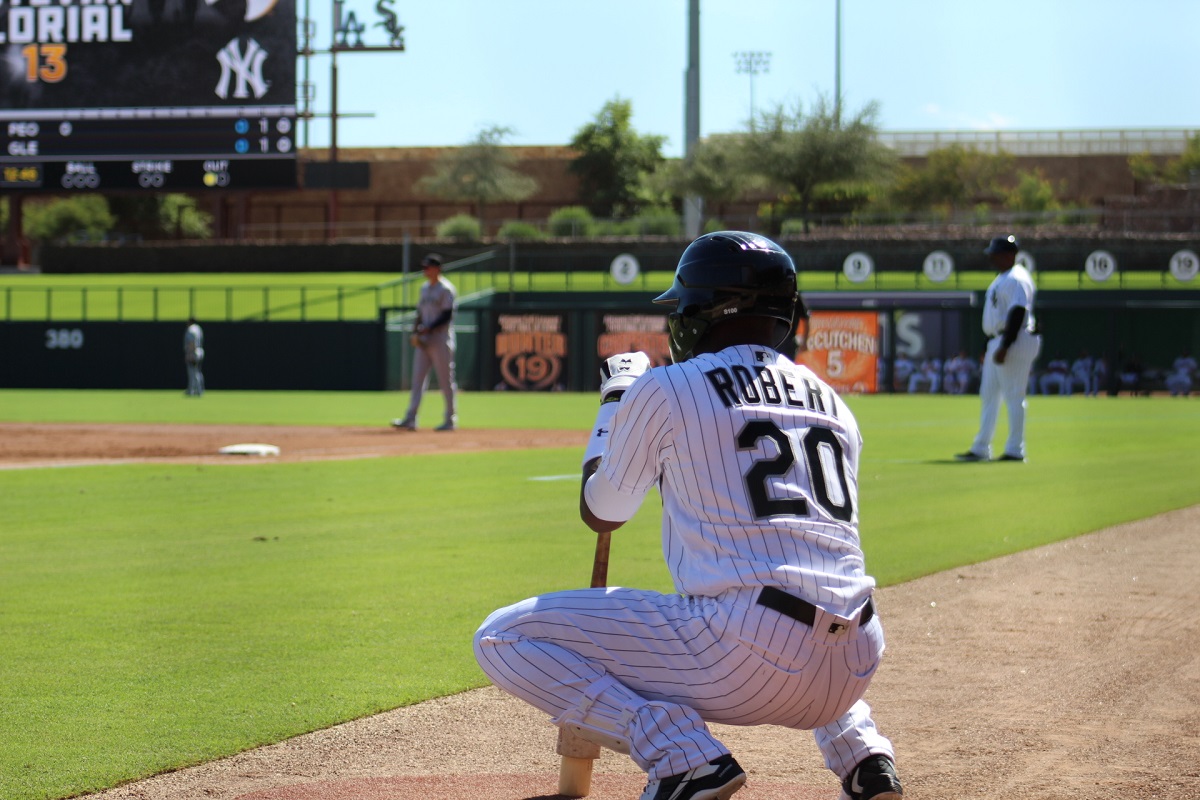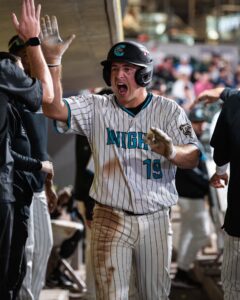Top 30 White Sox prospect rankings midseason 2020

It’s later than normal, but it’s time for our midseason prospect rankings update at FutureSox. Twice a year our writers work together to produce a ranked list of the top 30 White Sox prospects. We use a voting system among the staff, then argue about specific players and rankings until we come to a final list.
We release the list in two parts. First was scouting reports on prospects ranked 16-30. This is the full list. We also have scouting reports on players who just missed the top 30.
ELIGIBILITY: We consider a prospect any player in the White Sox organization who has not yet achieved MLB rookie status.
Zack Collins and Danny Mendick graduated since the preseason list. Luis Alexander Basabe was claimed off waivers by the San Francisco Giants and the White Sox added some prospects via the draft.
1. Luis Robert, OF (Previous: 1)
- Signed from Cuba in 2017
What’s left to be said about Robert at this point? He’s been terrific in his rookie season and is a favorite for AL Rookie of the Year. He’s hitting .279/.329/.574 with 10 home runs in the first 35 games of his career. His power is off the charts and he has shown in it big moments for the White Sox. Robert is still very aggressive at the plate, which leads to ugly looking at-bats at times, but that’s part of his game. Over time, expect those ugly at-bats to become more rare and his walk rate to go up, turning him into a more well-rounded hitter. In a normal year he wouldn’t have still been on our midseason list, but the trade deadline passed with Robert just shy of reaching rookie eligibility.
2. Andrew Vaughn, 1B (Previous: 3; +1)
- Drafted 1st Round (3rd overall) in 2019
With a regular minor league season in 2020, Vaughn would’ve been set to play in Birmingham this year. That would’ve been the first big test of his young professional career. Instead, he got valuable extended time around the big league club during Summer Camp. Vaughn showed flashes of an impact bat that will be a force in the White Sox lineup for a long time as he got to face major league arms, or guys close to it. He also spent some time playing third base, but a permanent position change does not seem likely for Vaughn. Upon the wrap up of Summer Camp, Vaughn was immediately sent to the Schaumburg alternate site where it seems like he will remain for the rest of the season.
3. Michael Kopech, RH SP (Previous: 2, -1)
- Drafted 1st Round Supplemental (33rd overall) in 2014 by Red Sox, acquired via trade Dec. 2016
Kopech remains on the list once again. After missing all of the 2019 season due to rehabbing from Tommy John surgery, Kopech opted out of the 2020 season. The last time he pitched in a meaningful game was Sept. 5, 2018. However, he did throw one inning during spring training where he flashed elite velocity still. He sat in the high 90s and reached triple digits multiple times during his lone inning of work. It’s unfortunate that Kopech will miss another season, but the elite arsenal and work ethic make him worthy of remaining a top three prospect in the organization.
4. Nick Madrigal, 2B (Previous: 4)
- Drafted 1st Round (4th overall) in 2018
Madrigal’s brief stint in the majors has been comically similar to his scouting report. In 37 plate appearances, Madrigal has no extra-base hits, one walk and three strikeouts. Oh, and he’s hitting .389. His contact rate allows for him to hit for high average, even if he doesn’t hit for power. It will be interesting to see how the league adjusts to his approach. Madrigal is able to make decent contact on a wide variety of pitches. Will some of these line drives and nubbers stop resulting in hits at some point? Madrigal will have to hit for a very high average to be a valuable hitter, but in a small sample size he is more than doing that.
5. Garrett Crochet, LH SP (New)
- Drafted 1st Round (11th overall) in 2020
Crochet has a power arm and has drawn comparisons to Chris Sale due to his 6-foot-6 frame and lower arm angle from the left side. His fastball was typically 96-97 mph in college, but has flashed triple digits. His slider and changeup grade out as above-average as well and give him a balanced arsenal. Command is the thing Crochet needs to improve as a pro. He hasn’t been erratic, but needs some refinement in that area. He has been working out in White Sox camp in Schaumburg, which is giving him plenty of time with professional coaches. Crochet could be a quick mover if the White Sox want.
6. Jared Kelley, RH SP (New)
- Drafted 2nd Round in 2020
Kelley fell to the White Sox in the second round, but he is a first-round talent. He has a mid 90s fastball and a plus changeup that give him two pitches that overwhelmed high school hitters. He has also shown advanced command for his age. From that perspective, Kelley could move relatively quickly in the minors, at least for a high schooler. The key with Kelley is improving his breaking ball. Some scouts viewed his breaking ball as below average, but he has plenty of time to work on that. Like Crochet, he joined White Sox camp in Schaumburg this summer.
7. Dane Dunning, RH SP (Previous: 5, -2)
- Drafted 1st Round Supplemental (29th overall) in 2016 by Nationals, acquired via trade Dec. 2016
Dunning could have been in the majors last season if not for Tommy John surgery which cost him the entire year. Major League Baseball’s return in 2020 lined up fairly nicely with Dunning’s return schedule. Instead of having a rehab assignment in the minors, Dunning had to work out in Schaumburg before he was ready. He has proven to be ready. Dunning struck out seven in his MLB debut against the Detroit Tigers and followed up with five no-hit innings against the Kansas City Royals in his second start. Dunning is still working on getting his stamina back, but his four-pitch mix has proven effective. He has a nasty slider with command of a solid mid 90s fastball leading the way.
8. Jonathan Stiever, RH SP (Previous: 6, -2)
- Drafted 5th Round in 2018
Stiever had a breakout 2019, but he hasn’t had the chance to build on that this year. He entered spring training with a forearm strain, but is pitching with White Sox coaches in Schaumburg. Stiever could be an emergency option as a starting pitcher, but there are a number of guys ahead of him. If Stiever is healthy and performs well, 2021 is likely when he makes his MLB debut. The right-hander has a mid 90s fastball and a good curveball. His slider and change are not as advanced, but give him a four-pitch arsenal. If he doesn’t improve his changeup, he could become a good reliever with that two-pitch combo, but he profiles as a starting pitcher.
9. Matthew Thompson, RH SP (Previous: 8, -1)
- Drafted 2nd Round in 2019
The White Sox deviated from their recent college heavy approach to the draft when they selected this Texas prep right-hander in the second round in June of 2019. Some evaluators saw Thompson after a decrease in velocity late in his high school season but the White Sox saw him often and loved the repertoire. The 6-foot-3, 195-pound righty has an athletic and projectable frame that produces a mid 90s fastball at present. The 20-year-old also throws a slider, curveball and changeup. The organization took it easy with Thompson to close out his first professional season in 2019, where he got two innings of work. Thompson was eventually added to the Schaumburg site where he will continue to work on his development despite not being able to play in a minor league game in 2020.
10. Andrew Dalquist, RH SP (Previous: 9, -1)
- Drafted 3rd Round in 2019
Dalquist was drafted a round after Thompson out of Redondo Union High School in California. Similar to Thompson, he was given a $2 million bonus to join the organization and begin his career. The 6-foot-1, 180-pounder throws his fastball in the 91-93 mph range and touches 95. Extension in his delivery creates deception and he should add more velocity with increased strength. Dalquist throws his curveball in the mid 70s with depth and also employs a slider and changeup. He projects as a mid-rotation starter and like Thompson, Dalquist was also added to the Schaumburg site where he will work on his development in 2020.
11. Micker Adolfo, OF (Previous: 10, -1)
- Signed from Dominican Republic in 2013
Adolfo missed most of 2019 recovering from Tommy John surgery before short stints in rookie ball and the Arizona Fall League. Now, he is working out with the group in Schaumburg. It will give him plenty of coaching time with White Sox staff and he will see high-level pitching, but he needs game reps. At 6-foot-4 and 240 pounds, the first thing that stands out about Adolfo is his physique. He’s still just 23 so time is on his side and he has the tools. It’s a matter of turning that into production in games.
12. Luis Gonzalez, OF (Previous: 14, +2)
- Drafted 3rd Round in 2017
Gonzalez got to make his MLB debut this season, but is still down the depth chart a bit. His ability to play all three spots in the outfield is a big boost to his value. Last season in Double-A Birmingham, Gonzalez got off to a slow start, like much of the lineup, before rebounding in the second half. He hit .230/.288/.324 in the first half and .280/.370/.398 in the second half. He’s got good speed and draws a good amount of walks. Gonzalez doesn’t have much pop and his bat won’t allow him to play at a corner outfield spot, but he can play a competent center field. In his MLB debut he dropped a fly ball and was hit by a pitch. He struck out in his only other MLB plate appearance before getting sent back down. He likely profiles as an above average utility player at this point.
13. Blake Rutherford, OF (Previous: 13)
- Drafted 1st round (18th overall) in 2016 by Yankees, acquired via trade July 2017
Not much has changed for Rutherford, who remains in the same spot this time around. After periods of struggles in Double-A and the Arizona Fall League in 2019, Rutherford entered spring camp with noticeably added muscle to his frame. During the spring in a small sample, he was hitting the ball hard and hitting the ball in the air consistently, as he was looking to bounce back from last season. He hasn’t shown power in games yet, which will be necessary to make Rutherford a big leaguer. With no minor league season, Rutherford has been in Schaumburg where he has been able to continue to get work in.
14. Jimmy Lambert, RH SP (Previous: 16, +2)
- Drafted 5th Round in 2016
Lambert was among a group of pitchers to take advantage of expanded rosters to make the White Sox on Opening Day. He appeared to have big league stuff in two relief appearances. Lambert struck out two and gave up two hits and no walks in two innings. In his debut his fastball was mostly 93-95 mph, but his second time out it sat mostly 90-92. Perhaps that was adrenaline in his debut, but he went on the injured list the day after his second outing. Lambert was returning from Tommy John surgery and went on the IL with a forearm strain. He has been out since. Lambert showed he has big league stuff, but he has to stay healthy.
15. Gavin Sheets, 1B (Previous: 12, -3)
- Drafted 2nd Round in 2017
Sheets’ 2020 has been surprising to most people outside the White Sox organization. After a slow start in 2019, he rebounded to hit .289/.377/.478 in the second half for Double-A Birmingham. That was enough to vault him ahead of a number of other prospects who struggled throughout the year in Birmingham. However, the White Sox still haven’t sent Sheets to camp in Schaumburg while that group (Luis Gonzalez, Blake Rutherford, Micker Adolfo) is there. As a first baseman, Sheets has less positional value in general. On top of that, it is a position of depth for the White Sox. Jose Abreu, Edwin Encarnacion, Zack Collins, Yermin Mercedes and Andrew Vaughn are higher on the first base/designated hitter depth chart. This offseason he prepared for work in the outfield, but we haven’t had a chance to see that materialize with no minor league season.
16. Codi Heuer, RH RP (Previous: 24, +8)
17. Yolbert Sanchez, SS (Previous: 15, -2)
18. Zack Burdi, RH RP (Previous: 18)
19. Jake Burger, 3B (Previous: 29, +10)
20. Bryce Bush, OF (Previous: 22, +2)
21. Konnor Pilkington, LH SP (Previous: 17, -4)
22. Benyamin Bailey, OF (Previous: 27, +5)
23. Tyler Johnson, RH RP (Previous: 19, -4)
24. James Beard, OF (Previous: 25, +1)
25. DJ Gladney, 3B (Previous: 26, +1)
26. Matt Foster, RH RP (Previous: 32, +6)
27. Bernardo Flores, LH SP (Previous: 20, -7)
28. Bryan Ramos, 3B (Previous: 30, +2)
29. Jose Rodriguez, SS (Previous: 26, -3)
30. Jefferson Mendoza, C (New)
Photo credit: Sean Williams/FutureSox
Want to know right away when we publish a new article? Type your email address in the box on the right-side bar (or at the bottom on a mobile device) and click “create subscription.” Our list is completely spam free, and you can opt out at any time. Also, consider supporting FutureSox on Patreon! You can get early access to special articles and Patreon-only posts, in addition to more benefits.
Shop our exclusive merchandise! Show your support with FutureSox apparel.






Through their first 37 games, the White Sox have produced the following accumulative stats from their #2 hitters that includes games started in parenthesis: Yoan Moncada (28), Eloy Jimenez (6) and Yasmani Grandal (2).
.236 BA
.317 OBP
.426 SLG
.743 OPS
18 BB
47 SO
0 SB
Nick Madrigal has the hitting, contact and base running skills of the prototypical traditional #2 hitter. It was his primary role coming up through the White Sox system and the time is right for him to assume that spot as the 2020 season heads down the stretch and into the postseason. The White Sox need to start thinking about incorporating small ball into their game plan that has produced a lot of HR’s but too many SO’s. The White Sox are a near lock for the expanded playoffs. Once in the postseason, they will also face better pitching while the weather begins to cool off in October. Small ball would become a more important element in helping win closely contested and typically lower scoring ball games.
Tim Anderson missed some time on the IL but still has 3 SB’s in three attempts as their exclusive leadoff hitter when healthy. He has also been very efficient as his 82% career SB success rate would attest to. Madrigal at #2 would allow the White Sox to be a more aggressive team on the base paths at the top of their batting order and create more chaos for their opponents defense. He would provide more opportunity for manager Rick Renteria to implement the hit-and run, resulting in more SB’s and better RBI opportunities for their multitude of sluggers that follow. Aggressive base running at the top of the order would serve to unnerve their opponents pitchers and defenders while presenting more opportunities for their hitters to see fastballs rather than breaking balls.
I agree 100%! Playoff baseball is a different game. The aggregate team offense stats that make team look good are established against a lot of mediocre pitching that you don’t see in the playoffs. We need to be able to score “some” runs against top pitching to win a championship.
Where was Yermin Mercedes? He is still in the minors.
He made our “Just Missed” list: https://www.futuresox.com/2020/09/01/just-missed-prospects-outside-the-midseason-2020-top-30/